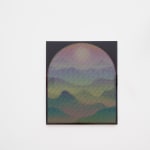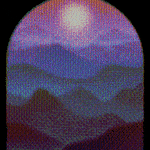



Nicolas Sassoon
RGB Study (Arch #1), 2024
Giclee print on MOAB archival paper, face mounted (UV acrylic, dibond), aluminum rail, unique digital moving image
116 x 134 x 2.5 cm
Unique
Copyright The Artist
Further images
RGB Study – Arch #1 (2024) is part of an extensive body of works entitled RGBStudies. All of the works comprising this series use a moiré patterning technique in which...
RGB Study – Arch #1 (2024) is part of an extensive body of works entitled RGBStudies. All of the works comprising this series use a moiré patterning technique in which two images overlap to create the illusion of a third image. I have developed this imaging process in my practice for the last 15 years and typically use it to create abstract works inspired by natural elements. In RGB Studies, I employ this technique to focus on landscape and atmospheric qualities within these scenes: mist rolling down mountains, rainstorms hitting valleys, sun rays filtering through clouds.
Moving image: https://nicolassassoon.com/RGBSTUDY_ARCH.html
The works from RGB Studies are rendered exclusively with the three primary colors—red, green, blue—and hard-edged pixel patterns. This method emulates theoptical illusion embedded in the structure of LCD screens: each pixel is physically composed of 3 primary-colored diodes. The distance between the screen and the human eye generates the illusion of seeing in millions of colors. This optical strategy isalso found in many artistic traditions, from weaving to painting. A particular point of reference for this body of work is Georges Seurat’s pointillism—paintings comprising thousands of multicolored dots which together form a discernible and radiant image.
RGB Studies features archetypal landscape imagery: mountains, valleys, islands, and forests in which most details are lost in a haze, leaving an overview of a topography where light filters through the atmosphere. The scenes disappear in the distance through gradual brightness, saturation, and blurring effects. Similar techniques to signify depth within a landscape are found in Italian Renaissance paintings and Chinese landscape painting beginning in the 6th century. Informed by these traditions and their respective techniques, RGB Studies digitally reinterprets visual information as pixelated graphics, kinetic motions, and moiré patterning to represent land and atmosphere.
Landscape imagery is significant in the formal explorations of RGB Studies for several reasons. Informed by graphics in early computers and video games from the 1980s—in which a few white pixels moving downwards become snow, or blinking dots on a blue rectangle become sun reflecting on the surface of a pond—I convey natural environments through minimal means. The graphics from this period are seemingly simple yet highly evocative; they also work within formalistic and technological constraints, efficiently transforming visual information into imaginative worlds. I spent my childhood and teenage years playing these games, but also outdoors near the ocean, growing up in coastal cities in France. These experiences could never be fully grasped, and would instead be recollected through the flashing memories and fleeting sensations of virtual and physical environments. My practice unites these worlds by mediating landscape and natural forces through digital abstraction. RGB Studies extends this research by reimagining traditional modes of representing land through a process derived from computer imaging. The resulting works are ambivalent, recollecting both old and new, idyllic and dystopic, abstract and figurative, digital and material.
Artist Bio:
Nicolas Sassoon is a Franco-Canadian artist using early computer graphics to create a wide array of pixelated forms & figures, moiré patterns & architectural structures. His work has long been concerned with the tensions between the pixel and the screen, reflecting on their entanglement and materiality by constraining himself to experiment with pixelated patterns and figures as his sole visual language. This focus on early computer graphics is driven by the sculptural, material and pictorial qualities of this imagery, as well as its limitations and its poetics. A basis of Sassoon’s research centres on digital animations created using a moiré patterning technique; consisting in the overlap of two images to generate optical illusions. This body of work often features abstract animations informed by atmospheric and natural forces. The animations appear on screen as endless hypnotic surfaces, similar to all-over paintings or wallpapers in their composition. The optical properties of these works generate tensions and oscillations in the perception of depth and flatness within the space of the screen. Sassoon’s work also manifests in physical space as sculptures, prints, and monumental projections scaled to the architecture in context, generating experiences adjusted to the human body. At large, Sassoon’s practice relates to many histories of abstraction in painting, optical art, moving image and computer graphics.
Nicolas Sassoon currently lives between Montreal, Canada and Biarritz, France. He is a founder of the collaborative projects SIGNALS and WALLPAPERS. His work has been exhibited at The Whitney Museum of American Art (US), Eyebeam (US), Current Museum (US), Vancouver Art Gallery (CA), Plugin ICA (CA), Contemporary Art Gallery (CA), Charles H.Scott Gallery (CA), Western Front (CA), PRETEEN Gallery (MX), Victoria & Albert Museum (UK), the Centre d’Art Bastille (FR), House of Electronic Arts Basel (SW), Kunsthalle Langenthal (SW), Arti et Amicitiae (NL), MU Eindhoven (NL) , Today Art Museum (CN), Chronus art Center (CN), the Berlin Fashion Week (DE) and the New-York Fashion Week (US).
Moving image: https://nicolassassoon.com/RGBSTUDY_ARCH.html
The works from RGB Studies are rendered exclusively with the three primary colors—red, green, blue—and hard-edged pixel patterns. This method emulates theoptical illusion embedded in the structure of LCD screens: each pixel is physically composed of 3 primary-colored diodes. The distance between the screen and the human eye generates the illusion of seeing in millions of colors. This optical strategy isalso found in many artistic traditions, from weaving to painting. A particular point of reference for this body of work is Georges Seurat’s pointillism—paintings comprising thousands of multicolored dots which together form a discernible and radiant image.
RGB Studies features archetypal landscape imagery: mountains, valleys, islands, and forests in which most details are lost in a haze, leaving an overview of a topography where light filters through the atmosphere. The scenes disappear in the distance through gradual brightness, saturation, and blurring effects. Similar techniques to signify depth within a landscape are found in Italian Renaissance paintings and Chinese landscape painting beginning in the 6th century. Informed by these traditions and their respective techniques, RGB Studies digitally reinterprets visual information as pixelated graphics, kinetic motions, and moiré patterning to represent land and atmosphere.
Landscape imagery is significant in the formal explorations of RGB Studies for several reasons. Informed by graphics in early computers and video games from the 1980s—in which a few white pixels moving downwards become snow, or blinking dots on a blue rectangle become sun reflecting on the surface of a pond—I convey natural environments through minimal means. The graphics from this period are seemingly simple yet highly evocative; they also work within formalistic and technological constraints, efficiently transforming visual information into imaginative worlds. I spent my childhood and teenage years playing these games, but also outdoors near the ocean, growing up in coastal cities in France. These experiences could never be fully grasped, and would instead be recollected through the flashing memories and fleeting sensations of virtual and physical environments. My practice unites these worlds by mediating landscape and natural forces through digital abstraction. RGB Studies extends this research by reimagining traditional modes of representing land through a process derived from computer imaging. The resulting works are ambivalent, recollecting both old and new, idyllic and dystopic, abstract and figurative, digital and material.
Artist Bio:
Nicolas Sassoon is a Franco-Canadian artist using early computer graphics to create a wide array of pixelated forms & figures, moiré patterns & architectural structures. His work has long been concerned with the tensions between the pixel and the screen, reflecting on their entanglement and materiality by constraining himself to experiment with pixelated patterns and figures as his sole visual language. This focus on early computer graphics is driven by the sculptural, material and pictorial qualities of this imagery, as well as its limitations and its poetics. A basis of Sassoon’s research centres on digital animations created using a moiré patterning technique; consisting in the overlap of two images to generate optical illusions. This body of work often features abstract animations informed by atmospheric and natural forces. The animations appear on screen as endless hypnotic surfaces, similar to all-over paintings or wallpapers in their composition. The optical properties of these works generate tensions and oscillations in the perception of depth and flatness within the space of the screen. Sassoon’s work also manifests in physical space as sculptures, prints, and monumental projections scaled to the architecture in context, generating experiences adjusted to the human body. At large, Sassoon’s practice relates to many histories of abstraction in painting, optical art, moving image and computer graphics.
Nicolas Sassoon currently lives between Montreal, Canada and Biarritz, France. He is a founder of the collaborative projects SIGNALS and WALLPAPERS. His work has been exhibited at The Whitney Museum of American Art (US), Eyebeam (US), Current Museum (US), Vancouver Art Gallery (CA), Plugin ICA (CA), Contemporary Art Gallery (CA), Charles H.Scott Gallery (CA), Western Front (CA), PRETEEN Gallery (MX), Victoria & Albert Museum (UK), the Centre d’Art Bastille (FR), House of Electronic Arts Basel (SW), Kunsthalle Langenthal (SW), Arti et Amicitiae (NL), MU Eindhoven (NL) , Today Art Museum (CN), Chronus art Center (CN), the Berlin Fashion Week (DE) and the New-York Fashion Week (US).



